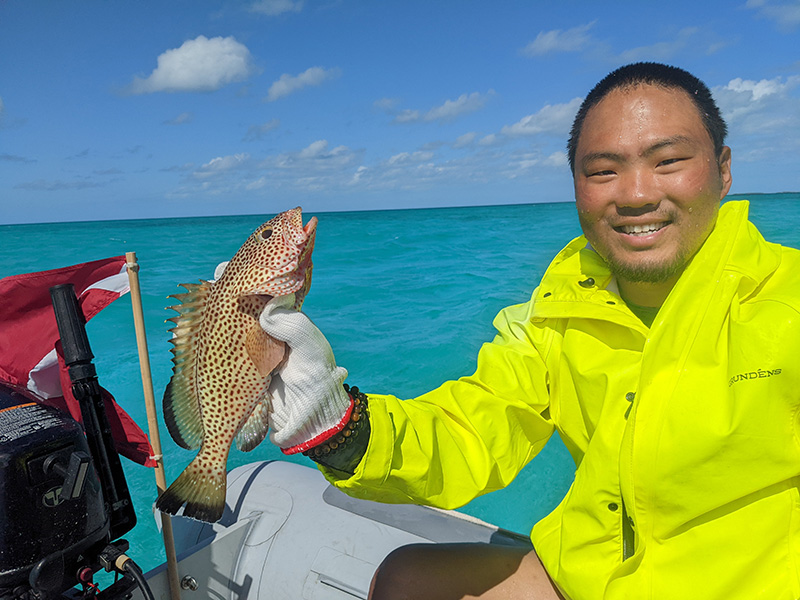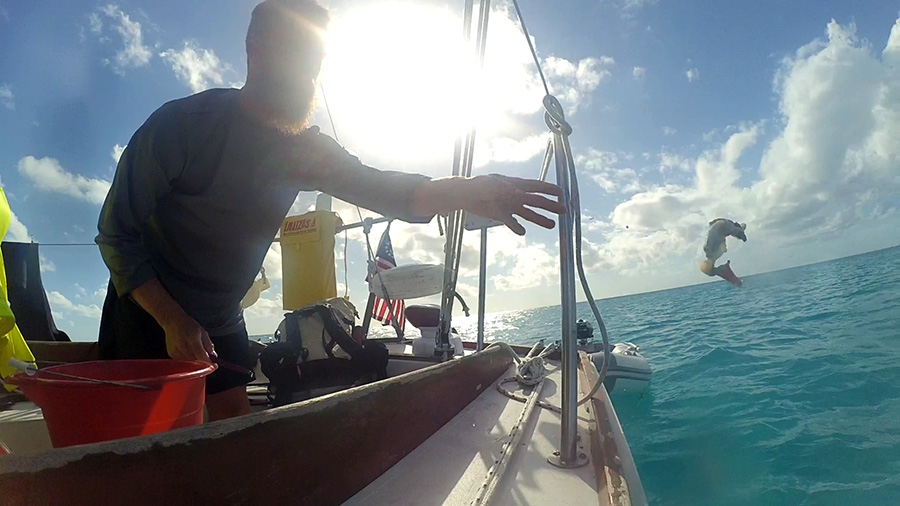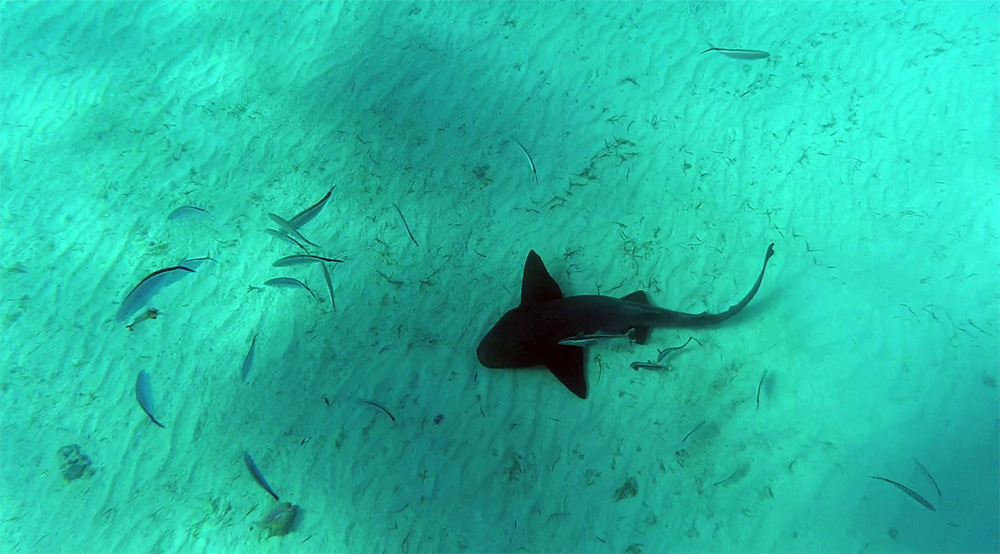
Our stay in the Promise Land would be a day shorter than planned. I was still glad to have been there. Months later, I’d be telling someone about my trip journey here. Folks’ eyes would light up whenever I mentioned that I had sailed to the Exumas, as if that legitimized my cruise to the Bahamas. Unfortunately, I also have to tell them I never saw the swimming pigs of the Exumas. If I feel comfortable with them, I tell them I also don’t care about those pigs. Otherwise, I prefer to leave folks with their pre-packaged dreams, filled with images that were injected by someone else. Not everyone is meant to, nor will enjoy discovery and exploration. Who is to say they are wrong? Maybe what we were doing is a huge waste of time and its better just to rush to well-proven highlights. I didn’t get to really explore much of the Exumas anyways. We sailed back on Friday, instead of Saturday due to a visit-ending incident.
After our time in Allen Cay, we moved a few miles south to Highborne Cay. The larger land mass was better at blocking the wave action crashing on the eastern coast of the island on the windward. On the charts, I saw two reef systems that looked interesting. The northern one, and the southern one, both of them half a kilometer from the cuts, where the currents will not affect us much. Rob also wanted to check out the dive marks placed on the charts next to the Oyster Cay. So today would be a day full of reef diving. We wouldn’t set foot on land; a fully aquatic day!
We hit the southern reefs first. We set the anchor in the sand between two reef systems. I dove the reef first with my spear, checking to make sure the anchor was dug in. After a quick thumbs up and acknowledgement, I swam towards the bigger reef. A patch of exposed old coral head was dotted with some newer rocks on top, perhaps only nine feet under the surface. It spread out in the size of a football field. The depressions in the exposed coral head were interesting. Each had a tiny, aggressive fish guarding their spot. Much like the ones I saw at Mermaid reef by Marsh Harbour, they would stare you down unwaveringly until you got really close. Eventually I came upon some larger rocks that had living coral and fish. By this time, Rob was in the water trailing me. This reef system was shallow, but vast. Great area for beginner hunters like u s.
I went over the first rock with my spear loaded. I had learned by now that the first pass over a reef is often the best time to take a shot. Just as well, because a small grouper held its ground as I approached it, deciding what to do. It wasn’t big, but it looked like it would make a full meal. It was yellow with black spots– a curious loud pattern. Grouper almost universally hang around and look at you, then quickly turn away. Not wanting to give it that chance, I let fly my spear. It found its mark. The spear went right through its mouth, only hitting the webbed, soft part of the jaw. It wasn’t the stone cold knockout shot I was looking for, but it also didn’t leave bits and pieces of fish and blood all around. Still, before any barracuda or sharks took notice, I wanted to get it back on the boat.
When the fish was on my spear, I finally noticed how tiny this fish was. It was only nine inches long, much smaller than I had initially thought. It might have been big enough for a meal, but it was still a very young fish. I now knew the reason for that coloration- in a quick glance, the fish appeared to be over a foot long. I pulled the fish off the spear and threw into the dinghy. Imagine watching this as Rob. He gets the funniest views, like he did in Spanish Wells. He sees me swim ahead to our first ‘bigger’ reef, then he seems me immediately swim back exactly the way we came from with a tiny, pathetic fish mysteriously appearing on a spear.

The crystal clear waters of the Exumas– yes, even clearer than the previous waters — and the shallow depth conspired to cover us in absolutely dazzling light. The sand was brilliant and the coral showed off its full range of coloration. The the full spectrum of colors come through to our bedazzled eyes.
Upon visiting some of the rocks on the way back to the dinghy, I noticed a nicely sized dog snapper looking at me. In a few moments, it darted into a hole. I haven’t caught a dog snapper yet. They are tricky. This one was a big one; probably at the upper limit of size that I consider to be safe from ciguatera poisoning. I remembered Bruce’s advice about stalking fish – hide from it in the hole, and when they relax their guard, float up to the hole and hit them when they are closer to the hole’s entrance. This rock wasn’t that big and I couldn’t quite dive beneath it. So I decided to float at the surface just behind the rock.
Sure enough, a few seconds later, the snapper swam out. I moved a bit to position the spear at an ideal angle to hit the fish. Mr. Snapper saw that and went back in the hole. I floated from a few different angles and this game of hide and seek was repeated a few times. Finally, I decided to switch to a left hand grip on the spear and peek right into the hole. There it was, Mr. Dog Snapper, carefully looking out from the hole. As it took its brief moment to decide what to do, I fired the spear. Solid head shot. It flopped a few times on my spear, then went limp. I had shot it right through its eye, spear exiting its opposite side gill.
It actually looked a bit gruesome and I felt disgusted for what I had done. But this was definitely a fish I was going to eat and the disgust was replaced by gratitude for the quick and humane kill. Rob was pretty stoked to see a good sized fish on the boat. During a pause in the excitement, we looked at the other fish on the boat. Miraculously, it was only minimally injured, not any greater than what a fish taken with a rod would have. And it was still alive. How do fish stay alive so long out of water? I would definitely be dead if I tried to do a breath hold as long as this fish have. After inspecting its injuries, we decided to let that one go. I grabbed it with a gloved hand and gently pushed it through the water by the boat. When it looked like it regained all of its consciousness, I let it go and it swam back towards the reef. Sorry, my guy.
We decided to try the spot by Oyster Cay. Apparently, the diving is more interesting on the windward side, but the current and waves were too gnarly. So we stayed on the leeward side, drifting down with the gentle current. This reef system was interesting. It sloped away from us, with the shallower parts close to the island’s coral head cliff’s. We couldn’t take any fish from this close to shore, so we just enjoyed the views while we were on that side. Although the water was deeper further out from shore, the rocks were not. They just got bigger and taller as it got further away from us. And so did the fish.
One of the things I noticed about the reef here was the presence of sponge. For the longest time, I thought sponges were named after the sponge we use to clean. Turns out that the inverse is true. Before synthetic sponge was invented, people used the same sponges I was seeing on this reef. Out in the Abacos and Eleuthera, sponge had been wiped out by over harvesting that happened about a century ago. Over here, they were making a come back, no doubt because there aren’t any real settlements here.
I observed the area for a bit and swam back to the dinghy to let Rob know that the reefs out further looked beautiful. We moved the dinghy and re-anchored, which was a bit challenging in the deeper water. We did not have enough rode to get a proper set. I took a huge breath and manually buried the anchor into the soft sand. The anchor held very well once I set it by hand. I returned to the boat, grabbed my spear, and started hunting again.

I took a shot on a school snapper but my spear just bounced off its tail. Dang. Now these guys will never let me get close. A bit later, possibly because I didn’t injure that grey snapper, the same school let me get closer again. They were visibly more nervous now. I dove on top of one, trying to stay relaxed as to conserve my oxygen, and got in an ideal position. They started to scatter. I noticed this back in the Abacos — schooling really does work against predators. Its more confusing to the predator, because the predator has to pick out a target to attack. And picking out a target ahead of time doesn’t really work because the chances the particular fish will give you a good opportunity is very low. But this school was smaller, only five decently sized fish. And fortunately, I am smarter than most predators at sea. I started watching them as a whole, and when they turned right, somewhat crossing my path. I took aim and let it fly. This time, the spear penetrated clean and hit the fish just below its spine, just behind the gills. I had missed its head, but it was still a good shot. I finally had some success with taking snapper!

With that, we decided to retire. I was pretty tired by then. We got back on Sonora pretty quickly and Rob immediately set out to clean the fish. We each had picked up a conch too, so we had plenty of work to do. As rob was tossing carcasses of the fish overboard, he noticed a grey shape swimming under Sonora. I thought it was a skate of some sort, which is a fish that is somewhat in between a ray and a shark, but Rob correctly identified it as a nurse shark. Nurse sharks have a broad set of pectoral fins, which makes it look more ray-like. Since they are shellfish eaters, it makes sense for them to be attracted to conch. I quickly got my camera out, mounted on a selfie stick, and got some footage of it. Rob jumped in the water and attempted to swim with it, but the smaller, fearful nurse shark quickly swam away. The commotion attracted small jacks as well, and they picked out bits and pieces as the material sank to the sea floor. A few remora that had been attached to the shark darted out to pick at the second-hand bits, then dart back onto the shark. We’d just come from fish paradise-land, but I thought this ad-hoc gathering under my little boat to a bit moving as well.
I said I was a smart predator a bit earlier, didn’t I? Nature has its ways to knock us back down a few notches. Rob informed me that he had lost his phone. We looked everywhere. On his boat, on my boat, under his boat, under my boat. We even dinghied back to the last reef we were on, and Rob went into the water to give it a quick look, racing against the setting sun. I knew the chances of recovering that phone was very slim. You really have to dive to the sea floor to give it a better look. Things are invisible from up above. But I respect that about Rob. I’d have given up after diving the boats. Maybe you can call it experience, having lost more objects to the sea than Rob has. But you do need a bit of tenacity to be a good cruiser, and Rob definitely had that. So we looked, looked, and looked. Unfortunately, we only had about an hour of daylight left, and the current at the last reef had picked up too much to safely continue to dive it.
Rob was so bummed out for the rest of the night. Party ruined! It must have bounced out of the dinghy at some point. I cooked up the fish and left him the bigger pieces before going back to my boat. The next day, we were supposed to move to Norman’s Cay to check out the settlement and go diving some more. But I was still physically recovering from the dive. Rob said he didn’t feel like moving either. The wind and waves picked up a bit too, so we both spent the day holed up in our boats, bouncing up and down but enjoying the blissful rest. That evening, I decided I needed to go back to Eleuthera on Friday, which was the next day, instead of Saturday. Saturday would be calmer, but I would barely have enough wind to sail. When I radioed him with my intentions, expecting to have to say our goodbyes, he said he had decided to do the same thing, so that he could get a replacement phone sooner.

Norman’s Cay would have to wait. Perhaps on another trip. My Exumas visit would be very short and there were no swimming pigs aside from me, but hey, I can at least tell people I’ve been to the Exumas!